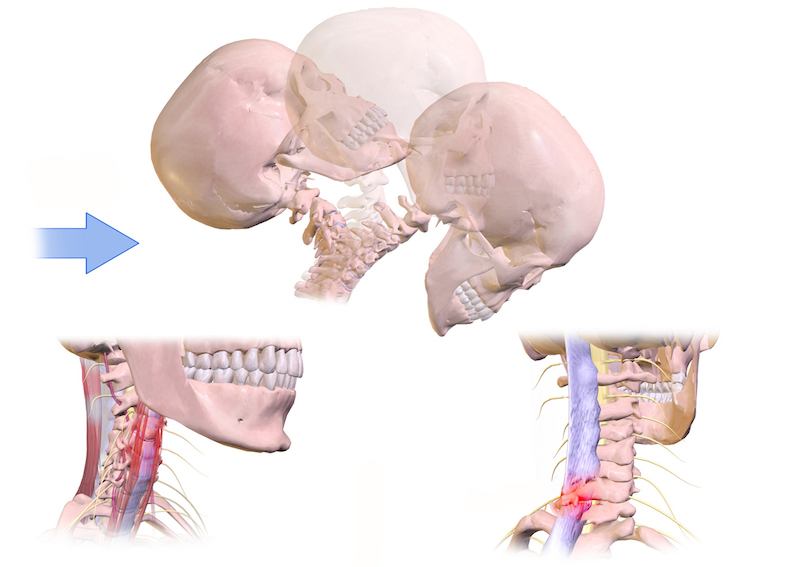Whiplash Pain
We have all experienced a minor fender-bender, the slight tap of our front bumper just kissing the back bumper of the car in front of us when we parallel park or slightly misjudge the distance at a stoplight. However, did you know that even at speeds as low as six miles per hour whiplash pain and injuries can occur? For low-speed collisions and other neck injuries and trauma, here’s what you need to know about whiplash pain.
What is whiplash?
Whiplash describes soft tissue injuries of the neck that can occur when the neck moves quickly to its extreme range of motion.
Consider the most common cause: car accidents. When a car traveling forward is suddenly stopped by an impact, a person’s body is restrained, but the head keeps moving forward. Once the head reaches the end of the range of motion, it snaps back. This sudden, forceful, and abnormal movement causes extensive injuries to the soft tissues, tendons, discs, facet joints, and ligaments in the neck.
Whiplash typically occurs following a car accident, but it also may occur following any activity that causes forceful movement of the neck, including:
- Falls
- Trauma
- Sports-related injuries
Whiplash can lead to pain for months, or even years, following the original accident.
In some cases, especially after car accidents, whiplash symptoms do not immediately appear. This is why it’s crucial to seek medical care as soon as possible after any accident, trauma, or injury to the neck.

What does whiplash feel like?
Whiplash may start as general soreness (from mild to extreme) in the neck but can progress.
Common symptoms associated with whiplash include:
- Neck pain
- Swelling along the back of the neck
- Muscle spasms
- Difficulty turning the head from side-to-side or moving it up and down
During this acute phase, an X-ray or MRI can assess the damage. Making sure to get a proper evaluation after an injury is an important part of successful pain management and treatment.
In some cases, symptoms that follow whiplash can require immediate, emergency medical attention. Go to the emergency room if you experience any of the following symptoms:
- Severe neck pain
- Dizziness
- Headache
- Weakness of the upper or lower extremities
What are whiplash treatments that can help?
Common treatment following a whiplash injury starts with rest and progresses from there. You may use over-the-counter, non-steroidal anti-inflammatory drugs (NSAIDs) to manage pain and inflammation. For muscle injury that accompanies whiplash, muscle relaxers may help. Comfort measures such as applying ice to ease swelling and heat to relax muscles can also relieve pain.
Chiropractic adjustments and decompression therapies can help relieve pain associated with whiplash. Common prescription medications used to treat whiplash pain include antidepressants and neuropathic medications. For all but a few cases, opioids are not generally recommended for either short- or long-term pain relief of whiplash.
After the acute phase passes, physical therapy can help to strengthen muscles in the neck, reducing pain and providing support.

Interventional treatments
For chronic neck pain related to whiplash injury, treatment options can still include chiropractic treatment, medication management, and physical therapy. Interventional treatments in addition can help manage severe or chronic pain.
One such example is injection therapy. Injection therapy is based on the type and location of the whiplash pain. For muscle spasms, trigger point injections can provide the most relief, whereas cervical epidural steroid injections are a good choice for radiating disc pain. For pain related to the cervical facet joints, medial branch blocks are a good choice.
The majority of chronic whiplash pain occurs in the facet joints. When this occurs, diagnostic and therapeutic facet injections or medial branch blocks have been found to be very helpful. Lidocaine or bupivacaine is injected along the medial branch nerves of the facet joint. If patients experience a 50% reduction in pain for the first several hours following injection, then the patient is a candidate for radiofrequency ablation of the medial branch nerves. Sometimes a second block will be performed to confirm the diagnosis.
Once the diagnosis is confirmed, radiofrequency ablation can help relieve the pain of chronic whiplash. The medial branch nerves transmitting pain signals are heated and destroyed in order to stop pain signals from reaching the brain. Research has shown that radiofrequency ablation can relieve whiplash pain for up to nine months.
Learn more
Most whiplash pain heals within six weeks of the initial injury. However, about 25% of people continue to have pain three months following the accident, and about 18% of people will continue to have pain after two years.
Chronic neck pain related to whiplash can be a life-changing condition. If you’re suffering from whiplash pain in Arizona, we can help. At Arizona Pain, we offer comprehensive, individualized treatments for chronic pain patients.